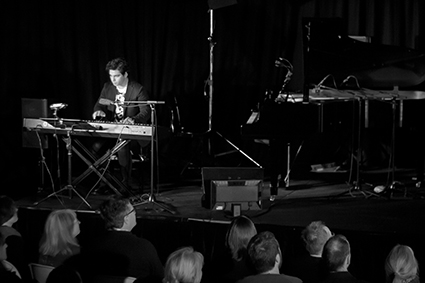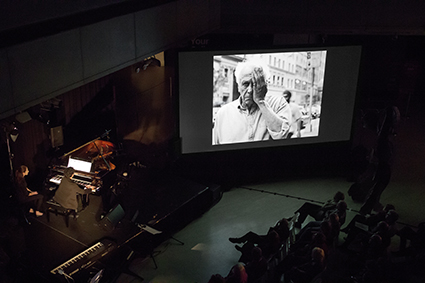Piano adventures
Laura Halligan: Totally Huge New Music Festival, Zubin Kanga, Dark Twin

Zubin Kanga
photo Holly Jade
Zubin Kanga
Nestled in plastic lawn chairs on the ground floor of the Art Gallery of Western Australia, the eighth night of the Totally Huge New Music Festival featured world-renowned Australian contemporary pianist, Zubin Kanga. He treated the audience to a performance of his Dark Twin program, playing Julian Day’s piece of the same name alongside a packed line-up of innovative electroacoustic works, which also appeared in Melbourne’s Metropolis New Music Festival earlier in May and later in Sydney.
The title of Stefan Prins’ Piano Hero for MIDI keyboard and live video refers to the popular game Guitar Hero, but in this case the work utilises MIDI keyboard to trigger playback of samples taken from a video recording of a pianist playing the inside of a prepared piano. The physicality demonstrated by the videoed pianist’s use of extended techniques is juxtaposed against the seemingly still live pianist: large gestures and loud sounds from the on-screen pianist were not matched by the live performer.
Dark Twin, composed by Julian Day and commissioned by Kanga, was easily one of the highlights of the night. Painstakingly workshopped over a period of months, the work begins with a simple idea that evolves throughout. The opening two-note tremolo transforms into a cluster chord that moves throughout the range of the piano and gradually becomes affected by the developing electronics. The electronic part itself is intended to be Kanga’s twin, but as is its nature, proves to be more dynamic than the acoustic baby grand piano in its ability to distort and process the live sound. Throughout, the electronics are subtle and slightly reserved, but ever-present and ominous. Nearing the end, the tremolo descends the range of the piano and the sonic cloud of the electronic part becomes darker and more present in the room until finally receding.

Zubin Kanga
photo Holly Jade
Zubin Kanga
For his composition _derivations, composer Benjamin Carey developed the program that controls its electronics as part of his PhD studies at the University of Technology, Sydney. Similar to speech recognition, it involves detecting a musical phrase once it is improvised, storing the collected musical gestures in a database and then later processing and manipulating them to form the basis of the duet that interacts with the performer’s improvisation in real time. The work was originally composed for solo saxophone and electronics but was premiered in Kanga’s program as a work featuring piano. The concept of the work is interesting; almost like the musical equivalent of a self-saucing pudding, but the accompaniment produced by the program became more of an indeterminable wash of sound as it layered phrases over themselves rather than as an articulate duet.
Transit, by Michel van der Aa for piano, video and electronics, was presented as a live film score—the composer’s Just Before—and his short black and white film, Passage, which follows the plight of an old man who suffers from loneliness but cannot leave his house. The piano score itself was sufficient; it paired predictable musical idioms that are associated with classic horror film scores with quasi-virtuosic piano writing, but the outcome was neither impressive nor disappointing. The film reminded me of student films put together for high school assignments; random and unnecessary camera angles, awkward cuts between scenes and distracting foley soundsnot synced to the video. With only a minute or so left, the film froze, leaving Kanga unable to finish.
Daniel Blinkhorn’s FrostbYte: Chalk Outline utilised piano and electronics to create a soundscape to accompany a video of images from the composer’s journey to the Arctic archipelago of Svalbard. It reflects the composer’s concern that climate change is destroying nature around him, the work forming part of Blinkhorn’s collection of electroECOustic works. The piano is processed with techniques used in electronic dance music and dubstep, creating a bassy and compressed electronic accompaniment. The piece was thought provoking: images of glaciers and icy oceans juxtaposed against industrial images—cranes and buildings. As more unnatural images were introduced the electronics became increasingly intense, leaving behind the serene soundscape that was originally established in the beginning of the work.
Cat Hope’s The Fourth Estate “explores the damaging influence that the media can have on all aspects of society” (program note). Hope’s graphic score details the use of e-bows to be placed directly on the strings of the piano, along with a radio tuned to static to be played within the piano. The pianist ‘realises’ the graphic notation through improvisation. The two additions to the piano were intended to interrupt the pianist’s realisation of the score, but the e-bows only created a subtle tone that felt more like a welcome aspect of the work, and at times the radio static got lost within the piano’s sound. The purpose of the radio and e-bows was to obstruct the sound of the improvising pianist, but the work’s performance did not match its political intention.
Lastly, Kanga performed Steve Reich’s Piano Counterpoint in an arrangement by Vincent Corver of the 1977 work Six Pianos. This arrangement features one live pianist, the other five parts being pre-recorded. Piano Counterpoint represents the epitome of minimalism, and its consistent rhythmic repetitiveness proves to be extremely calming. The evolving nature of the work requires concentration and focus and Kanga, considering its length, showed off his technical prowess and the intense musicality and physicality of his playing.






